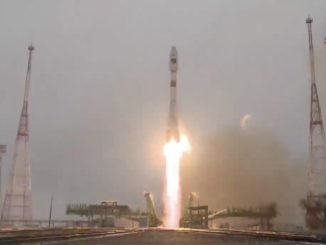EDITOR’S NOTE: Updated with new launch date of Aug. 14.

Arianespace is returning an Ariane 5 rocket — loaded with three U.S.-built satellites — back to its final assembly building in French Guiana to replace a suspect sensor on the vehicle that prompted officials to cancel a launch attempt Friday. Arianespace said Monday that the swap will delay the launch until around Aug. 14.
The European-built launcher was set for takeoff Friday from the Guiana Space Center on the northeastern shore of South America. But the automated countdown stopped around two minutes prior to launch time after a problem with a sensor on the Ariane 5’s first stage liquid hydrogen tank.
“Ariane 5 is being transferred back to the Final Assembly Building (BAF), where a spare sensor will be set up and a new flight program uploaded to the launcher,” Arianespace said in a statement Saturday. “These additional operations, and those that follow, will take several days. In the meantime, the Ariane 5 launch vehicle and its three spacecraft payloads are in stable and safe conditions.”
Arianespace, the French launch service provider, said Monday that the next launch attempt could be around Aug. 14. Officials said a launch Aug. 13 might be feasible after firming up the troubleshooting schedule.
After Friday evening’s scrubbed launch attempt, teams in French Guiana drained the Ariane 5 rocket’s liquid hydrogen and liquid oxygen propellant tanks and began securing the vehicle for rollback to the assembly building.
The Ariane 5 rocket is slated to launch with a pair of U.S.-built communications satellites and Northrop Grumman’s second Mission Extension Vehicle, a spacecraft designed to dock with other satellites in geostationary orbit, a belt located more than 22,000 miles (nearly 36,000 kilometers) over the equator.
The mission will be the first Ariane 5 flight to carry three multi-ton geostationary satellites on a single mission. The Ariane 5 rocket typically launches with two large geostationary payloads on commercial flights.
The MEV-2 and Intelsat’s Galaxy 30 communications satellite are connected together inside the upper berth of the Ariane 5’s voluminous payload fairing. Both satellites were built by Northrop Grumman in Dulles, Virginia.
Galaxy 30 will provide commercial video and television broadcast services over North America, and also hosts a navigation augmentation payload for the Federal Aviation Administration. After launch and reaching geostationary orbit, MEV-2 will autonomously dock with the Intelsat 10-02 communications satellite — which is low on fuel — and take over propulsion duties, extending the spacecraft’s useful life.
The BSAT-4b satellite launching in the lower position inside the Ariane 5 fairing was built by Maxar in Palo Alto, California. Owned by the Japanese operator B-SAT, the BSAT-4b satellite will be positioned over the Asia-Pacific to provide direct-to-home television broadcast services.
The Ariane 5 rocket set to launch the three geostationary satellites is also testing several upgrades, including modified pressure vents on its payload fairing. Engineers will gather data on the changed vent configuration to ensure it meets stringent requirements for the launch of the $10 billion James Webb Space Telescope on an Ariane 5 rocket next year.
The launch vehicle also has a lighter vehicle equipment bay, a part of the rocket that contains the Ariane 5’s avionics and guidance systems. That increases the Ariane 5’s lift capability by about 187 pounds, or 85 kilograms, according to Arianespace.
And the Ariane 5 is testing a new autonomous location system, which will eventually be used operationally on Europe’s next-generation Ariane 6 rocket. The autonomous system will use signals from Europe’s Galileo navigation satellites to determine the rocket’s location, streamlining range safety requirements, which currently rely on extensive ground infrastructure, such as radars, to track rockets as they depart the Guiana Space Center.
Email the author.
Follow Stephen Clark on Twitter: @StephenClark1.



